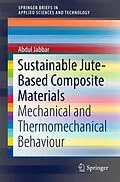This book shows how jute waste is collected from industry and used as a cheaper source to extract and use cellulose. Novel environment-friendly methods are explored for surface modification of natural fibers. The advantages of using biocomposites are listed and the author shows how they can be used effectively as secondary structural parts.
Autorentext
Abdul Jabbar is a PhD scholar in the Department of Material Engineering Technical University of Liberec, Czech Republic and a lecturer at the National Textile University Faisalabad, Pakistan.
Zusammenfassung
This book shows how jute waste is collected from industry and used as a cheaper source to extract and use cellulose. Novel environment-friendly methods are explored for surface modification of natural fibers. The advantages of using biocomposites are listed and the author shows how they can be used effectively as secondary structural parts.
Inhalt
Introduction.- Literature Review.- Research Methodology.- Effect of Pulverized Micro Jute Fillers Loading on the Mechanical, Creep and Dynamic Mechanical Properties of Jute/Green Epoxy Composites.- Extraction of Nanocellulose from Waste Jute Fibers and Characterization of Mechanical and Dynamic Mechanical Behavior af Nanocellulose Coated Jute/Green Epoxy Composites.- Flexural, Creep and Dynamic Mechanical Evaluation of Novel Surface Treated Woven Jute/Green Epoxy Composites.- Conclusions and Future Work.
Titel
Sustainable Jute-Based Composite Materials
Untertitel
Mechanical and Thermomechanical Behaviour
Autor
EAN
9783319654577
ISBN
978-3-319-65457-7
Format
E-Book (pdf)
Hersteller
Herausgeber
Veröffentlichung
28.08.2017
Digitaler Kopierschutz
Wasserzeichen
Dateigrösse
4.73 MB
Anzahl Seiten
101
Jahr
2017
Untertitel
Englisch
Unerwartete Verzögerung
Ups, ein Fehler ist aufgetreten. Bitte versuchen Sie es später noch einmal.
